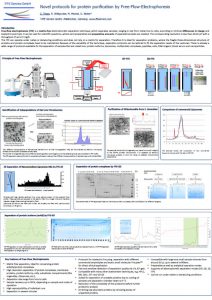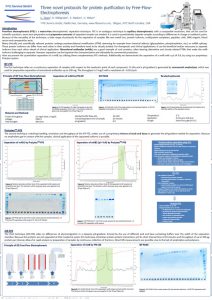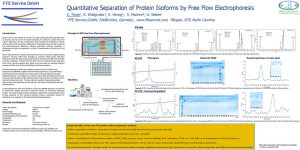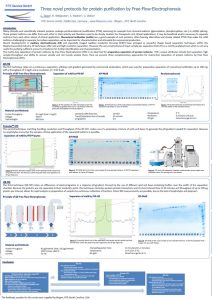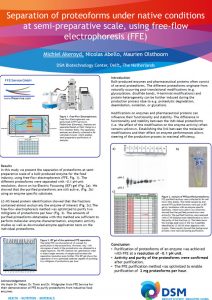Conference Posters
Novel protocols for protein purification by Free-Flow-Electrophoresis
Joint Meeting of the Membrane Sections of the French and German Biophysical Societies” held on April 11 – 14, 2016 in Bad Herrenalb, Germany.
Abstract
Free-flow electrophoresis (FFE), also known as ”carrier-free electrophoresis”, is an electrophoretic separation technique, which separates preparative and semi-preparative amounts of samples, ranging in size from metal ions to cells, according to minimal differences in charge and isoelectric point (pI). Because it is a matrix-free technique, that operates in standard buffer systems and allows for a cooled environment, it maximizes the preservation of protein activity and structural integrity of protein complexes and bio particles, leading also to high recovery rates.
It is compatible with a wide range of electrophoretic modes, like isoelectric focusing (IEF) or interval zone electrophoresis (IZE), that allow for high resolution separation (< 0.02 ΔpH) with a high throughput (up to 3.5 mg protein/h) in short amounts of time (less than 10 minutes separation time). In the past this technique has proven to be useful for the separation of a lot of different samples including protein complexes, organelles, liposomes/vesicles, protein isoforms and nanodiscs.
Three novel protocols for protein purification by Free-FlowElectrophoresis
Biologics & Biosimilars Congress, Berlin, 2016 and AT Europe 2016 in Vienna
Abstract
A lot of clinically and scientifically relevant proteins, like monoclonal antibodies (mAB), undergo posttranslational modifications (PTM) stemming for example from glycosylation or mRNA splicing. These protein isoforms can differ from each other in their activity and therefore have to be closely studied and possibly separated from each other ahead of clinical application.
Here we present three complementary approaches for matrix-free separation of protein isoforms by Free Flow Electrophoresis (FFE). Its fast separation, high samplethroughput and -recovery make the FFE an ideal tool for semi-preparative separation of protein isoforms. All techniques allow for tailor-made separation conditions to fit the needs of the operator and the protein samples, to ensure native separation conditions.
The first technique (IEF-FFE) relies on a continuous separation, utilizing a pH-gradient generated by commercial ampholytes, which was used for preparative separation of monoclonal antibodies up to 100 mg with a throughput of 3 mg/h and a resolution of < 0.02 Δ-pH.
The second technique (ProLytesTM-FFE), matching handling, resolution and throughput of the first technique, makes use of a proprietary mixture of acids and bases to generate the pH-gradient needed for separation. Because no ampholytes encounter the samples, clinical application of the separated isoforms is possible.
The third technique (IZE-FFE) relies on differences of electromigration in a stepwise pH-gradient, formed by the use of different acid and base containing buffers over the width of the separation chamber. Because the proteins are not separated at their isoelectric point, this technique minimizes protein-protein interactions and its short interval time of 10 minutes and throughput of up to 100 µg protein per interval, allows for high throughput analysis or preparation of samples by continuous collection of fractions.
Because of their high resolution and collection of significant amounts of sample, these techniques can be used as a preparative extension for capillary electrophoresis (CE) or other analytical techniques for further characterization of protein isoforms by MS or potency assays.
Quantitative Separation of Protein Isoforms by Free Flow Electrophoresis
CE-Pharm Meeting, New York, 2015
Abstract
Protein isoforms are defined as variants of a single polypeptide which generally alter its function. More than 90% of naturally occurring isoforms arise from post translational modifications (PTMs) and less than 10% from mRNA splice variations. In many cases, PTMs change the biological activity of proteins. Therefore their properties have to be closely studied before being administered as a drug.
Here, we introduced Continuous Horizontal Isolelectric Focussing Free Flow Electrophoresis (CHIEF-FFE) to isolate up to 100 milligram amounts of individual protein isoforms of mABs under native conditions that enable further biological studies. Resulting fractions were well suited for direct use in further studies such as enzyme- and/or immune-assays.
In contrast to competing technologies like capillary electrophoresis (CE) and imaged capillary isoelectric focusing (iCIEF) we are able to separate semi-preparative amounts of protein in a very fast workflow.
Variable lengths of electromigration and a variable span of pH, generated by using homemade ampholytes, gives us total control over protein separation. Zooming into ultra-flat pH gradients resulted in a resolution of 0.02 ∆pI between single fractions. Combined with rapid UV detection we were hereby able to separate and characterize multiple isoforms of different samples in quantitative amounts.
Novel iZE Separation Of Monoclonal Antibody Isoforms By Free Flow Electrophoresis
CE-Pharm Meeting, New York. 2015
Abstract
A lot of clinically and scientifically relevant proteins, like monoclonal antibodies (mAB), undergo posttranslational modifications (PTM) stemming for example from glycosylation or mRNA splicing. These protein isoforms can differ from each other in their activity and therefore have to be closely studied and possibly separated from each other ahead of clinical application.
The matrix-free separation of these proteins by Free Flow Electrophoresis (FFE) with its fast separation, high sample-throughput and -recovery make the FFE an ideal tool for semi-preparative separation of protein isoforms.
In a different approach we demonstrated the separation of mAB isoforms by Continuous Horizontal Isoelectric Focusing FFE (CHIEF-FFE). Here the protein isoforms were separated in an electrical field, by using an ampholyte containing buffer, to establish a continuous pH gradient. This approach results in a resolution of 0.02 ∆pI between single fractions and was therefore very well suited for isolation of single isoforms.
In a novel approach mAB isoforms were separated by FFE in interval zone electrophoresis (iZE) mode. The buffers used for interval zone only contain well defined chemicals (one acid, one base and mannitol) and no polymers or ampholytes to form a stepwise pH gradient. Thus, this technique is compatible for direct clinical and pre-clinical applications or crystallography.
No publication available.
Three novel protocols for protein purification by Free Flow Electrophoresis
PEGS Europe, Lisbon, 2015
Abstract
A lot of clinically and scientifically relevant proteins, like monoclonal antibodies (mAB), undergo posttranslational modifications (PTM) stemming for example from glycosylation or mRNA splicing. These protein isoforms can differ from each other in their activity and therefore have to be closely studied and possibly separated from each other ahead of clinical application.
Here we present three complementary approaches for matrix-free separation of protein isoforms by Free Flow Electrophoresis (FFE). Its fast separation, high sample-throughput and -recovery make the FFE an ideal tool for semi-preparative separation of protein isoforms. All techniques allow for tailor-made separation conditions to fit the needs of the operator and the protein samples, to ensure native separation conditions.
The first technique (IEF-FFE) relies on a continuous separation, utilizing a pH-gradient generated by commercial ampholytes, which was used for preparative separation of monoclonal antibodies up to 100 mg with a throughput of 3 mg/h and a resolution of < 0.02 Δ-pH.
The second technique (ProLytesTM-FFE), matching handling, resolution and throughput of the first technique, makes use of a proprietary mixture of acids and bases to generate the pH-gradient needed for separation. Because no ampholytes encounter the samples, clinical application of the separated isoforms is possible.
The third technique (IZE-FFE) relies on a stepwise pH-gradient, formed by the use of different acid and base containing buffers over the width of the separation chamber. Because the proteins are not separated at their isoelectric point, this technique minimizes protein-protein interactions and its short interval time of 10 minutes and throughput of up to 100 µg protein per interval, allows for high throughput analysis or preparation of samples by continuous collection of fractions.
Because of their high resolution and collection of significant amounts of sample, these techniques can be used as a preparative extension for capillary electrophoresis (CE) or other analytical techniques for further characterization of protein isoforms by MS or potency assays.
Application Notes
Guideline for the enrichment of proteins from FFE-fractions
Native FFE Fractionation of human serum
Isolation of peroxisome subpopulations from rat liver by immune free-flow electrophoresis
